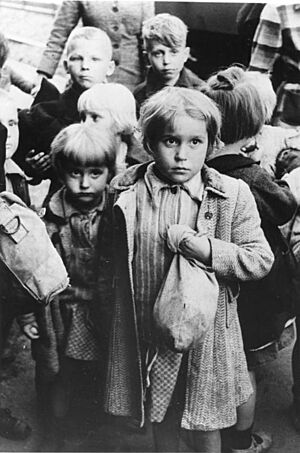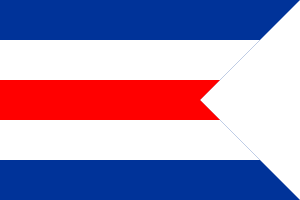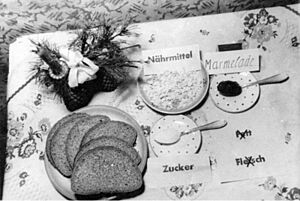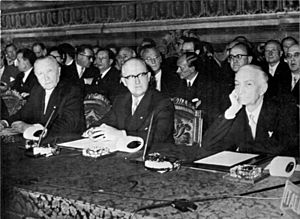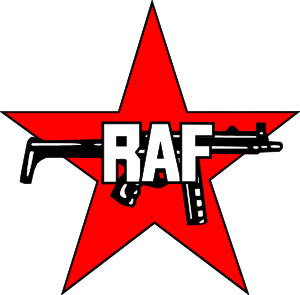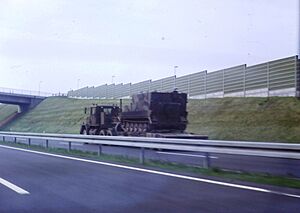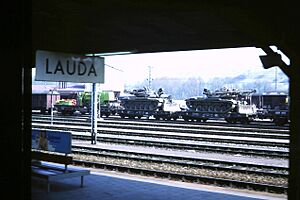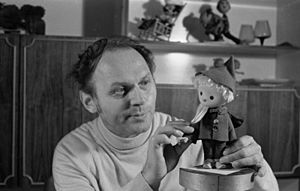History of Germany (1945–1990) facts for kids
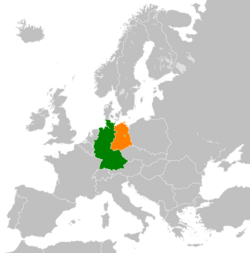 |
|
West Germany |
East Germany |
|---|---|
The history of Germany from 1945 to 1990 covers the time after World War II. It began on June 5, 1945, when Nazi Germany was officially ended and the Allied powers took control. It finished on October 3, 1990, when Germany was reunited.
After Germany lost World War II in 1945, it lost some of its land. More than a quarter of its old territory was taken by Poland and the Soviet Union. Many German people living in these areas had to move to the west. The Saarland region was controlled by France from 1947 to 1956.
After the war, about eight million people from other countries were in Germany. Most were forced laborers and prisoners. This included about 400,000 survivors from Nazi concentration camps. Millions more had died in these camps. Between 1944 and 1950, about 12 to 14 million German-speaking refugees arrived in Germany from eastern areas. Sadly, about two million of them died on their journey.
As the Cold War began, Germany was split into two parts. The western part was allied with the United States. The eastern part was allied with the Soviet Union. Two separate German countries were formed:
- The Federal Republic of Germany, also called West Germany, was created on May 23, 1949. It was a democracy with a free economy.
- The German Democratic Republic, also called East Germany, was created on October 7, 1949. It was a socialist country controlled by the Soviet-aligned Socialist Unity Party.
Under Chancellor Konrad Adenauer, West Germany became good friends with France, the United Kingdom, the United States, and Israel. West Germany also joined NATO and the European Economic Community. East Germany's economy struggled because it was controlled by the government. The Stasi, East Germany's secret police, watched people closely. The Berlin Wall was built in 1961 to stop people from escaping to the West. Germany was reunited on October 3, 1990, after the East German government lost power.
Contents
How Germany Was Divided
Four Military Zones
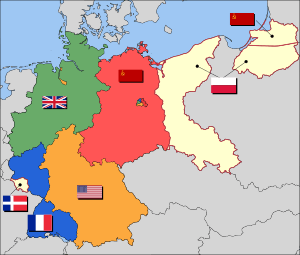
At the Potsdam Conference in 1945, the Allies officially divided Germany. This happened after Germany surrendered on May 8, 1945. Germany was split into four military zones. France controlled the southwest, the United Kingdom the northwest, the United States the south, and the Soviet Union the east. The new border with Poland was along the Oder-Neisse line.
The Allies agreed that Germany's territory would be based on its borders from December 31, 1937. Any land Germany had taken between 1938 and 1945 was no longer considered part of Germany. This included places like Austria and parts of Poland.
Germans Forced to Move
Many ethnic Germans had to leave their homes after the war. The northern part of East Prussia was given to the Soviet Union. The southern part of East Prussia and the city of Danzig became part of Poland. The Allies had agreed to this at earlier conferences.
About 12.4 million ethnic Germans lived in areas that became part of Poland and the Soviet Union. Around 6 million fled before the Soviet army arrived. Of those who remained, about 2 million died. Another 3.6 million were forced out by the Poles. The Sudetenland, which Germany had taken from Czechoslovakia, was returned. Many ethnic Germans there were also expelled.
The Potsdam Conference allowed for the "orderly and humane" transfer of ethnic Germans to Germany. However, many were treated very badly. Thousands died in forced labor camps or from hunger, disease, or cold during their journey.
About 8 million German refugees settled in West Germany, and 3 million in East Germany. In West Germany, these refugees became an important group. They wanted Germany to be reunited and hoped to return to their lost homes in the East. They also sought money for their losses.
The Allied Control Council was supposed to govern all of Germany. It included commanders from the United States, United Kingdom, France, and the Soviet Union. However, France often blocked efforts to create a single German government. Berlin, located in the Soviet zone, was also divided into four sectors. West Berlin was controlled by the Western Allies, and East Berlin by the Soviets.
Rebuilding Germany After the War
Ending Nazi Influence
A main goal for the Allies was to remove all signs of the Nazi regime. This process was called "denazification." Nazi symbols like the swastika were banned. A temporary German flag was created. It was used until East and West Germany were formed in 1949.
The Allies had planned to treat Germany as one economic unit. But these plans failed. France and the Soviet Union wanted to take as much as possible from their zones to help rebuild their own countries. The plan completely broke down in 1948 when the Soviets blocked West Berlin. This was the start of the Cold War.
The Allies did agree to put the main Nazi leaders on trial for their crimes. This was one of the few things they agreed on. To keep the Western Allies in Berlin, the U.S. agreed to leave some areas in exchange for Berlin being divided into four parts.
At first, U.S. soldiers were not allowed to be friends with German citizens. This rule was later relaxed. By September 1945, the rule was dropped.
Limiting German Industry in the West
The Allies wanted to reduce Germany's ability to wage war again. They planned to lower Germany's industrial power. At the Potsdam Conference, the Allies decided to destroy all German military factories. They also limited civilian industries that could be used for military purposes. This meant reducing steel production to only 25% of what it was before the war. Car production was cut to 10%.
By 1950, equipment had been removed from many factories in West Germany. Steel production was greatly reduced. Timber was also heavily exported from the U.S. zone to destroy Germany's "war potential" in forests.
As the Cold War began, Western policies changed. It became clear that West German industry needed to recover. This was important for all of Europe and for West Germany to become an ally against the Soviet Union. In 1946, U.S. Secretary of State James F. Byrnes gave a famous speech in Stuttgart. He said that the U.S. would no longer follow policies that hurt Germany's economy.
In 1947, the U.S. decided that Europe's economy could not recover without Germany's help. President Harry S. Truman changed the policy. He said that a "stable and productive Germany" was needed for a "prosperous Europe."
However, the dismantling of factories continued. In 1949, West German Chancellor Konrad Adenauer asked the Allies to stop. He pointed out that it was hard to encourage growth while removing factories. The dismantling mostly stopped by 1951. All limits on German industry were lifted after the European Coal and Steel Community was formed in 1951. However, making weapons remained forbidden.
Relations with France
Upper Silesia, a major industrial area, was given to Poland. The International Authority for the Ruhr was created to control Germany's industrial Ruhr region. France wanted to keep the Ruhr under international control. But in 1951, France agreed to let West Germany join the European Coal and Steel Community. This meant Germany's coal and steel markets would be shared with other European countries.
The Saar region was controlled by France from 1946. The U.S. supported this because France had been invaded by Germany three times. The Saar returned to Germany in 1957 after a vote by its people.
In 1954, France voted against a plan to create a European Defense Community. This plan would have created a shared European army. Later, Germany was allowed to rearm under the Western European Union and then NATO.
Dismantling in East Germany
The Soviet Union removed a huge amount of industrial equipment from its zone. This was much more than what the Western powers took. The Soviets needed to rebuild their own country after the war. This heavy removal of resources hurt East Germany's economy and made its people unhappy. This was a key reason for the formal split of Germany.
Marshall Plan and New Money
The Western Allies worried about the economy in their zones. So, the American Marshall Plan provided economic aid to West Germany in 1948. A new currency, the Deutsche Mark, was introduced. This stopped the high inflation. The Marshall Plan helped West Germany's recovery, but other factors were also important.
The Soviets did not agree to the new currency. In March 1948, they left the four-power governing groups. In June 1948, they started the Berlin blockade. They blocked all ground routes between West Germany and West Berlin. The Western Allies responded with a continuous airlift of supplies to West Berlin. The Soviets ended the blockade after 11 months.
Payments to the U.S.
The Allies took valuable German intellectual property, like patents. They used these to help their own industries. From 1945 to 1947, the U.S. actively collected German scientific and technological knowledge. This meant that no industrial research could happen in Germany during this time. Thousands of German scientists were also sent to work in the U.S.
Food Shortages
During the war, Germans had taken food from occupied countries. This stopped in 1945, and food supplies in Germany became very low. The U.S. Army sent food to feed prisoners of war and the general population. For several years after the war, Germans had very little food. International aid mostly went to victims of the Nazis, not Germans.
In 1945, the average German civilian in the U.S. and UK zones received only 1200 calories a day. This did not include food from their own gardens or the black market. By October 1945, the British government noted that German civilian death rates were four times higher than before the war. Child death rates were ten times higher. The German Red Cross was dissolved, and other aid groups were restricted from helping Germans. The food situation got even worse in the cold winter of 1946–1947.
Forced Labor as Payment
As agreed by the Allies, Germans were used for forced labor as part of war payments. German prisoners were forced to clear minefields in France and other countries. By December 1945, about 2,000 German prisoners were killed or injured each month in France. In Norway, 275 German soldiers died clearing mines by August 1945.
New States in Germany
On December 17, 1947, the Saar Protectorate was created under French control. It became part of West Germany on January 1, 1957, after a vote.
On May 23, 1949, the Federal Republic of Germany (West Germany) was formed in the Western zones. Bonn became its temporary capital. It had 11 new states. West Germany became a fully sovereign state on May 5, 1955.
On October 7, 1949, the German Democratic Republic (East Germany) was formed in the Soviet Zone. East Berlin became its capital.
In 1952, the Soviet leader Stalin suggested reuniting Germany. He also proposed that superpowers leave Central Europe. But Britain, France, and the United States rejected this offer. West German Chancellor Konrad Adenauer wanted to connect more with the West.
West Germany and East Germany were informally known as "West Germany" and "East Germany." Troops from the former occupying powers remained in both countries. Berlin was a special case. It was divided into East and West Berlin, with West Berlin surrounded by East German territory. West Berliners were citizens of West Germany, but West Berlin remained under Allied control until 1990.
West Germany was allied with the United States, the United Kingdom, and France. It was a democratic country with a "social market economy." It saw huge economic growth, known as the "Wirtschaftswunder" (economic miracle), starting in the 1950s. This was helped by the Marshall Plan and increased demand for goods during the Korean War (1950–53).
East Germany was allied with the Soviet Union.
West Germany (Federal Republic of Germany)
The Western Allies gave more power to West German officials. They helped create a central Economic Council for their zones. This led to a West German assembly, rules for relations with the Allies, and the merging of the French, British, and American zones. On May 23, 1949, the Grundgesetz (Basic Law), which is West Germany's constitution, was announced. After elections in August, the first government was formed on September 20, 1949, led by Konrad Adenauer. His government was a mix of different parties. The next day, West Germany gained self-government with some exceptions.
In 1949, Bonn became the new temporary capital of West Germany. Chancellor Konrad Adenauer strongly supported Bonn, which was close to his hometown. Many politicians preferred Frankfurt, but others worried it would become a "permanent" capital. This might make people forget about reuniting Germany and returning the government to Berlin.
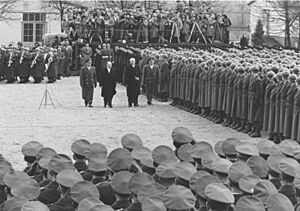
After an agreement in 1949, West Germany quickly moved towards full independence. It joined its European neighbors and the Atlantic community. Agreements in 1954 gave West Germany most of its independence back in May 1955. This also allowed Germany to join NATO. In April 1951, West Germany joined the European Coal and Steel Community, which was the start of the European Union.
When the Korean War began in June 1950, the U.S. wanted West Germany to rearm. This was to help defend Western Europe from the Soviet threat. But other European countries worried about German aggression again. So, they wanted strict control over the West German military. The countries in the Coal and Steel Community decided to create a European Defence Community (EDC). This would have an integrated army, navy, and air force. The West German military would be fully controlled by the EDC.
The EDC treaty was signed in May 1952 but never started. France's leaders rejected it, saying it threatened their country's independence. When the French National Assembly refused to approve it in August 1954, the treaty failed. Other ways were found to allow West Germany to rearm. The Brussels Treaty was changed to include West Germany, forming the Western European Union (WEU). West Germany was allowed to rearm and control its military. The WEU would set limits on the size of each member's armed forces.
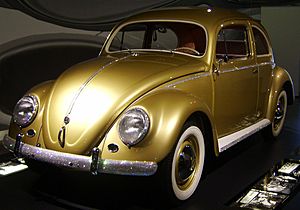
Between 1949 and 1960, West Germany's economy grew incredibly fast. Low inflation, small wage increases, and rising exports helped restore the economy. This brought a good level of wealth. Official numbers show that Germany's economy grew by about 7% each year between 1950 and 1960.
| 1951 | 1952 | 1953 | 1954 | 1955 | 1956 | 1957 | 1958 | 1959 | 1960 |
| + 10.5 | + 8.3 | + 7.5 | + 7.4 | +11.5 | + 6.9 | + 5.4 | +3.3 | + 6.7 | +8.8 |
The demand for housing, tools, chemicals, and cars, along with growing farm production, started this "economic miracle." This time is linked to Ludwig Erhard, who was the Minister of Economics. Unemployment was 10.3% at the start of the decade but dropped to 1.2% by 1960. This was almost full employment.
Millions of displaced people and refugees from the East were integrated into the workforce. By the end of the 1950s, thousands of young East Germans were moving to the West. This caused a growing problem for East Germany. When the Berlin Wall was built in August 1961, they hoped to stop this loss of workers. But this created a new problem for West Germany: how to find enough workers. The answer was to hire workers from Southern European countries. This began the era of Gastarbeiter (foreign laborers).
In October 1961, an agreement was signed with Turkey. The first Gastarbeiter began to arrive. By 1966, about 1,300,000 foreign workers had been hired, mainly from Italy, Turkey, Spain, and Greece. By 1971, this number reached 2.6 million. The original idea was that single workers would come for a few years and then return home. But many workers brought their families and settled in Germany because wages were much higher there.
In the 1950s, West Germany's laws for compensating Nazi victims were limited. Only those who suffered for "racial, religious, or political reasons" could get compensation. This definition greatly reduced the number of people who could receive money. For example, millions of forced laborers from Eastern Europe were excluded. Also, the law excluded homosexuals, Romani people, and others who were considered "criminals" by the Nazi state.
A 1953 study showed that out of 42,000 survivors of the Buchenwald concentration camp, only 700 were eligible for compensation under the law.
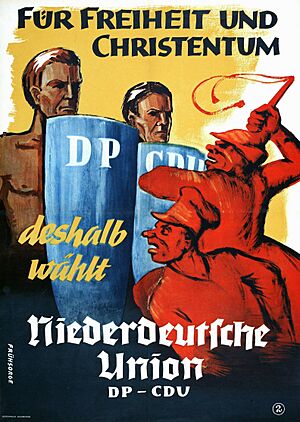
West German authorities worked to end the denazification process started by the Allies. They also released some war criminals from prison. However, they also tried to prevent any political support for the Nazi regime.
Until 1990, the three Western Allies kept some control in Berlin and over Germany as a whole. Allied troops stayed in West Germany for NATO defense.
Political life in West Germany was very stable. The time under Chancellor Adenauer (1949–63) was followed by Ludwig Erhard (1963–66) and then Kurt Georg Kiesinger (1966–69). All governments from 1949 to 1966 were coalitions led by the Christian Democratic Union (CDU) and Christian Social Union (CSU).
1960s: A Time for Change

In 1963, Chancellor Adenauer, who was 87, finally left office. He had wanted to stay in control of German politics for many more years. But he lost interest when he learned how limited the president's powers were.
In October 1962, a news magazine called Der Spiegel published an article about weaknesses in the West German military. Ten days later, police raided the magazine's offices. The Defense Minister, Franz Josef Strauss, ordered this. Chancellor Adenauer said the article was treason. The magazine's owner, Rudolf Augstein, was jailed. But public outcry about freedom of the press grew. Members of Adenauer's cabinet resigned, demanding Strauss's resignation. This event, known as the Spiegel affair, was a turning point. It showed that ordinary Germans wanted more democratic values. Adenauer's reputation was damaged, and he announced he would step down in 1963. His successor was Ludwig Erhard, who was seen as the father of the "economic miracle."
In the early 1960s, economic growth slowed down. This led to a recession in 1967. The economic slowdown forced Erhard to resign in 1966. He was replaced by Kurt Georg Kiesinger of the CDU. Kiesinger faced controversy because he had joined the Nazi Party in 1933.
Kiesinger's government (1966–69) was a "grand coalition" between the two largest parties, the CDU/CSU and the Social Democratic Party (SPD). This coalition allowed them to pass new, controversial "emergency acts." These laws allowed basic rights, like freedom of movement, to be limited during a state of emergency.

There was strong opposition to these laws. Groups like the German student movement and "Democracy in Crisis" protested against them.
Political Changes from 1969 to 1990
In the 1969 election, the SPD, led by Willy Brandt, formed a government with the FDP. Brandt was a very popular politician. He started a new policy called Ostpolitik. This policy aimed to improve relations with West Germany's eastern neighbors, especially East Germany. The CDU opposed this policy.
Brandt and Foreign Minister Walther Scheel (FDP) negotiated agreements with the Soviet Union, Poland, Czechoslovakia, and East Germany. These agreements greatly improved relations between East and West. They eventually led to the end of the Warsaw Treaty and Soviet control over Eastern Europe. In 1970, during a visit to Warsaw, Brandt knelt before a monument to those killed in the Warsaw Ghetto Uprising. This was a powerful gesture of humility.
Chancellor Brandt had to resign in May 1974. A senior member of his staff was discovered to be a spy for East Germany's secret police, the Stasi. Brandt won the Nobel Peace Prize in 1971 for his work towards world peace.
Finance Minister Helmut Schmidt (SPD) became Chancellor from 1974 to 1982. He strongly supported the European Community and the Atlantic alliance. Throughout the 1970s, the Red Army Faction continued its terrorist attacks, targeting politicians and police.
In January 1979, the American TV series Holocaust was shown in West Germany. About 20 million people watched it. This was the first time many Germans learned about the genocide during World War II. After each part of the series, historians answered questions from viewers. Many young Germans said they were born after 1945 and had never known about their country's role in the genocide. By the late 1970s, young people began demanding that concentration camp sites be turned into museums and places of remembrance.
In 1980, the CDU/CSU chose Franz Josef Strauss as their candidate for chancellor, but he lost to Schmidt. In October 1982, the SPD-FDP government broke apart. The FDP joined with the CDU/CSU to elect CDU chairman Helmut Kohl as Chancellor. Foreign Minister Hans-Dietrich Genscher stayed in his role. After elections in March 1983, Kohl gained strong control of the government. The Green Party also entered parliament for the first time. In 1983, despite protests, Kohl's government allowed American Pershing II missiles to be stationed in West Germany. This was to counter Soviet missiles in East Germany.
East Germany (German Democratic Republic)
In the Soviet occupation zone, the Social Democratic Party was forced to merge with the Communist Party in April 1946. This created the Socialist Unity Party of Germany (SED). The SED became the main party in the region.
The SED, guided by the Soviets, drafted a constitution. It was adopted on October 7, 1949, when East Germany was officially formed. A parliament was created. On October 11, 1949, Wilhelm Pieck was elected President. The Soviet Union and its allies immediately recognized East Germany. Most non-communist countries did not recognize it until 1972–73. East Germany became a one-party communist state. All government control was in the hands of the SED.
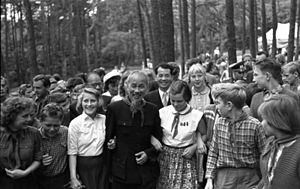
The National Front was a group that included the SED and other parties controlled by the SED. It also included youth, trade unions, women's, and cultural groups. But the SED held all the power. Voting in East German elections was not secret. Participation was always very high, and the SED always received over 99% of the votes. For example, in 1963, two years after the Berlin Wall was built, the SED got 99.95% of the votes. These results are often questioned.
Industry and Farming in East Germany
When East Germany was formed in October 1949, it faced many problems. Cities were in ruins, and much of its industrial equipment had been taken by the Soviet Union. While West Germany received financial help from the U.S., East Germany had to send goods to the USSR. This was a heavy burden on its people.
The SED wanted to turn East Germany into a socialist and then a communist state. This would happen step by step through economic planning. In July 1952, Walter Ulbricht of the SED announced that building socialism would be the main goal. This meant that the government, military, and planning of industry and farming would be controlled only by the SED. Industries would be owned by the state, and farms would be collectivized (run by the state).
When the first Five-Year Plan was announced, more people started leaving East Germany. Production fell, food became scarce, and protests happened in factories. On May 14, 1952, the SED ordered workers to produce 10% more, but their wages stayed the same. This decision was not popular.
On June 5, 1953, the SED announced a "new course." Farmers, craftspeople, and factory owners would get some relief from controls. But the new production quotas remained. East German workers protested, and strikes occurred the next day. Strikers marched to the SED headquarters, demanding that the production quotas be removed. The crowd grew, and a general strike was called for the next day.
On June 17, 1953, strikes and protests happened in 250 towns and cities. Between 300,000 and 400,000 workers took part. They mainly wanted the production quotas removed. They believed in socialism but felt the SED had made a mistake.
The SED responded with force, with help from the Soviet army. Thousands were arrested and jailed. Many hundreds were forced to leave for West Germany. The SED later softened its policies, but the damage was done. The true nature of the East German government was revealed. The SED claimed West German agents caused the strikes, but there is no proof. Over 250 strikers, about 100 police, and 18 Soviet soldiers died in the uprising. June 17 was declared a national day of remembrance in West Germany.
Berlin
After World War II, Berlin was the headquarters of the Allied Control Council. This council was supposed to govern all of Germany. But in 1948, the Soviet Union stopped working with the other powers. They also refused to share control of Berlin. They forced the elected Berlin government out of the Soviet sector and set up a communist government in East Berlin.
From then until reunification, the Western Allies kept control of their sectors in West Berlin. They gave control of city affairs to the elected West Berlin government. The Allies and German authorities in West Germany and West Berlin never recognized the communist government in East Berlin.
West Berlin was 176 kilometers (110 miles) inside East Germany. The Western Allies encouraged a close relationship between West Berlin and West Germany. West Berlin representatives attended the West German Parliament as non-voting members. West German agencies also had offices in West Berlin. The Allies consulted with West Germany and West Berlin on foreign policy issues.
Between 1948 and 1990, major events like fairs and festivals were held in West Berlin. Investment in businesses was encouraged with special tax breaks. These efforts, along with good city management, helped West Berlin thrive. Its industrial production grew beyond pre-war levels.
The Final Settlement Treaty ended Berlin's special status in 1990. Under this treaty, Berlin became the capital of a united Germany. In June 1991, the German parliament voted to make Berlin the seat of government. Government offices have been moving to Berlin, and it became the formal seat of the federal government in 1999. Berlin is also one of Germany's 16 states.
Relations Between East and West Germany
Under Chancellor Konrad Adenauer, West Germany claimed the right to speak for the entire German nation. This was called the Hallstein Doctrine. It meant West Germany would not recognize East Germany. It also limited diplomatic relations with countries that recognized East Germany as a sovereign state.
Many East Germans kept fleeing to West Germany. This caused tension between the two countries in the 1950s. East Germany closed its borders to West Germany in 1952. But people still fled from East Berlin to West Berlin. On August 13, 1961, East Germany began building the Berlin Wall around West Berlin. This stopped the flow of refugees. The Wall cut the city in half and made West Berlin an island in communist territory. The Wall became a symbol of the Cold War and the division of Europe. Soon after, the main border between the two German states was also fortified.
In 1969, Chancellor Willy Brandt announced that West Germany would stay allied with the West. But it would also work to improve relations with the Eastern Bloc, especially East Germany. This policy was called Ostpolitik. West Germany started by negotiating non-aggression treaties with the Soviet Union, Poland, Czechoslovakia, Bulgaria, and Hungary.
Relations between West and East Germany were especially difficult. West Germany wanted to help divided families and reduce tension. But it still believed in "two German states in one German nation." Relations slowly improved. In the early 1970s, Ostpolitik led to a form of mutual recognition. Several treaties helped normalize relations. Both states joined the United Nations in September 1973. The two German states exchanged representatives in 1974. In 1987, East German leader Erich Honecker made an official visit to West Germany.
Aftermath
Even today, there are big differences between the former East and West Germany. These include differences in lifestyle, wealth, and political beliefs. So, people still talk about eastern and western Germany separately. The eastern German economy has struggled since unification. Large amounts of money are still transferred from west to east to help it.
See also
 In Spanish: Historia de Alemania desde 1945 para niños
In Spanish: Historia de Alemania desde 1945 para niños


